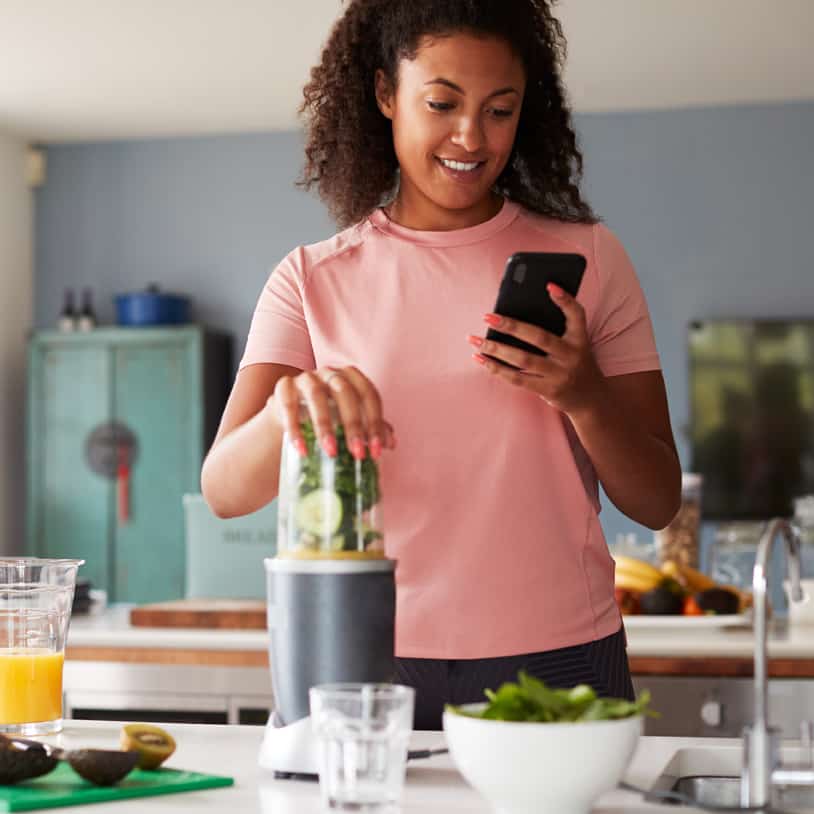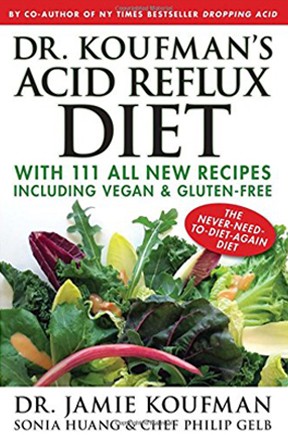
Is Juicing or a “Juice Cleanse” Good or Bad for Acid Reflux?
At-A-Glance
- If you have acid reflux and you are going to do a “juice cleanse” or just juice regularly, you should avoid ingredients and brands that are overly acidic, because they are bad for your reflux.
- The optimal pH (acidity) of your “juice” should always be pH 5 or higher. And to help those of you who make your own juice, I have provided the pH of common ingredients in this post.
- Juicing is a $3.4 billion industry, which suggests that most people are buying prepackaged (bottled or canned) products. I have also pH-tested some of the juice/smoothie brands; and unfortunately, most are way too acidic … and some are carbonated, too.
- The health claims of juicing include weight loss and “detoxification”; however, a review of the medical literature (PubMed) does not substantiate those claims. And while I love a good smoothie, in my opinion, “juicing” is a gimmick, just another fad diet.
What’s Wrong With Juicing and Most Juicing Products? Too Acidic!
A key scientific discovery shared in my book, Dropping Acid, is that for refluxers, pepsin attaches itself to your tissue and it is pepsin that does all the damage. Pepsin, however, requires acid-activation, and we now know that damage to the respiratory tract occurs at pH <5. Thus, a Low-Acid Diet is recommended for refluxers. For the science, see What Is Pepsin?
Why is almost everything in a bottle or can so acidic? In 1973, following an outbreak of food poisoning, the FDA mandated that bottled/canned beverages crossing state lines must be pH <4, acidic enough to kill microorganisms. That’s when manufacturers started adding ascorbic, citric, and phosphoric acids to almost everything. And BTW, ascorbic acid is vitamin C. Watch out for “Vitamin C enhanced” on products; it’s there for product acidification, not to give you a vitamin C boost.
There is, however, an FDA alternative to acidification, and that’s pasteurization, which is high-temperature processing, again to kill microorganisms. This is why canned kidney beans, for example, aren’t acidic; they’ve been cooked and canned very hot, pasteurized.
If you are going to try a store-bought or on-line juice or smoothie, get the smallest quantity that you can, and test the product first before you invest a lot in it. You can use inexpensive regular pH paper. Make sure that the product is pH >5, because anything below that pH-level is bad for your reflux.
Common Good & Bad Juicing Fruit and Vegetable Choices for the Refluxer
Shown below is the pH of each item, tested using a state-of-the-art ISFET pH-meter. Note: pH results may vary; they may be affected by source, age, ripeness, and brand. I have made no attempt to test everything. There are, for example, a dozen or more types of apples available; the big difference seems to be between red and green, with green apples being consistently more acidic. Also, with “milk,” they are all close to pH 7. THE ENTIRE LIST IS SHOWN ALPHABETICALLY AT THE BOTTOM OF THIS POST
pH (Acidity) of Common Juicing Ingredients
Good
7.2 Coconut milk
7.2 Almond milk
7.0 Avocado
6.6 Spinach
6.6 Ginger root
6.5 Zucchini
6.5 Watermelon
6.4 Basil
6.3 Beet
6.2 Cilantro
6.2 Arugula
6.1 Parsley
6.1 Endive
6.1 Cucumber
6.1 Carrot
6.0 Kale
6.0 Cantaloupe
6.0 Bok choy
5.8 Fennel
5.8 Celery
5.7 Banana
5.7 Leek
5.6 Potato (Russet, cooked)
5.6 Collard greens
5.4 Coffee (black)
5.3 Honeydew melon
5.2 Eggplant
5.1 Apple (red, Fuji)
Marginal
4.9 Onion (sweet Vidalia)
4.6 Tomato (Heirloom)
4.5 Plum
4.5 Pear
4.5 Nectarine
4.4 Peach (fresh/ripe) NB: 3.0 frozen peaches, generic store brand
Bad
4.0 Strawberry
3.9 Cherries (Frozen), generic store brand
3.7 Grape (red and green)
3.7 Apple (green, Granny Smith)
3.5 Onion (red)
3.5 Kiwi
3.5 Blackberry
3.5 Apple sauce, generic grocery brand
3.4 Pineapple
3.4 Mango
3.3 Papaya
3.3 Grapefruit
3.1 Raspberry
3.0 Blueberry
3.0 Peaches (frozen), generic grocery brand
3.0 Apple cider vinegar
2.5 Lime
2.5 Lemon
pH of Grocery-Store-Bought Juicing Items (All Too Acidic!)
3.0 Bolthouse Farms Strawberry-Banana
3.0 Lenny Boy Kombucha Strawberry Limeade (carbonated)
3.0 Sambazon Acai Berry Amazon Energy (carbonated)
3.3 SuperB Blueberry Ginger (carbonated)
3.3 Synergy Raw Kombucha Multi-Green (carbonated)
3.4 Simple Truth Organic Cold Pressed Juice Blend
3.5 Simple Truth Organic Cold Pressed Citrus Cayenne
3.5 Synergy Raw Kombucha Mystic Mango (carbonated)
3.6 Bolthouse Farms Green Immunity Boost
3.7 Suja Organic Citrus Immunity
3.8 Naked Might Mango
3.8 Naked Power-C Machine
3.9 Suja Organic Mighty Dozen
4.0 Bolthouse Farms Strawberry Parfait
4.0 Naked Green Machine
Some Reference Items (pH)
2.7 Pepsi
3.0 Balsamic vinegar
3.0 Dr. Pepper (diet)
3.1 Coke (diet)
3.2 Ginger ale (diet, Canada Dry)
3.2 Mountain Dew (diet)
3.3 Pickle/pickle juice
3.3 Red Bull
4.2 Seltzer (carbonated water)
7.0 My tap water
pH-Balancing
If you combine acidic and alkaline items, you can achieve pH-balancing. For example, combine equal amounts of a pH 4 item with another that is pH 6, and the combination will be pH 5.
Here are some tricks: I freeze my pH 9.5 (Cerra) alkaline water in old-fashion Ice Trays and use 2-4 cubes along with a banana (pH 5.7) in smoothies so that I can add some acidic fruits like pears red apples, and berries. Your finished juices or smoothies should be at the minimum above pH 5, and the higher the pH, the better.
Again, get some pH paper because it is all you need to check pH; and, the key to pH-balancing is experience, that is, trial and error. Have fun!
Alphabetical List
Almond milk 7.2
Apple (green, Granny Smith) 3.7
Apple (red, Fuji) 5.1
Apple cider vinegar 3.0
Apple sauce, generic grocery brand 3.5
Arugula 6.2
Avocado 7.0
Banana 5.7
Basil 6.4
Beet 6.3
Blackberry 3.5
Blueberry 3.0
Bok choy 6.0
Bolthouse Farms Green Immunity Boost 3.6
Bolthouse Farms Strawberry Parfait 4.0
Bolthouse Farms Strawberry-Banana 3.9
Cantaloupe 6.0
Carrot 6.1
Celery 5.8
Cherries (Frozen), generic store brand 3.9
Cilantro 6.2
Coconut milk 7.2
Coffee (black) 5.4
Collard greens 5.6
Cucumber 6.1
Eggplant 5.1
Endive 6.1
Fennel 5.8
Ginger root 6.6
Grape (red and green) 3.7
Grapefruit 3.3
Honeydew melon 5.3
Kale 6.0
Kiwi 3.5
Leek 5.7
Lemon 2.5
Lenny Boy Kombucha Strawberry Limeade (carbonated) 3.0
Lime 2.5
Mango 3.4
Naked Green Machine 4.0
Naked Might Mango 3.8
Naked Power-C Machine 3.8
Nectarine 4.5
Onion (red) 3.5
Onion (sweet Vidalia) 4.9
Papaya 3.3
Parsley 6.1
Peach (fresh/ripe) NB: 3.0 frozen peaches, generic store brand 4.4
Peaches (frozen), generic grocery brand 3.0
Pear 4.5
Pineapple 3.4
Plum 4.5
Potato (Russet, cooked) 5.6
Raspberry 3.1
Sambazon Acai Berry Amazon Energy (carbonated) 3.0
Simple Truth Organic Cold Pressed Citrus Cayenne 3.5
Simple Truth Organic Cold Pressed Juice Blend 3.4
Spinach 6.6
Strawberry 4.0
Suja Organic Citrus Immunity 3.7
Suja Organic Mighty Dozen 3.9
SuperB Blueberry Ginger (carbonated) 3.3
Synergy Raw Kombucha Multi-Green (carbonated) 3.3
Synergy Raw Kombucha Mystic Mango (carbonated) 3.5
Tomato (Heirloom) 4.6
Watermelon 6.5
Zucchini 6.5









